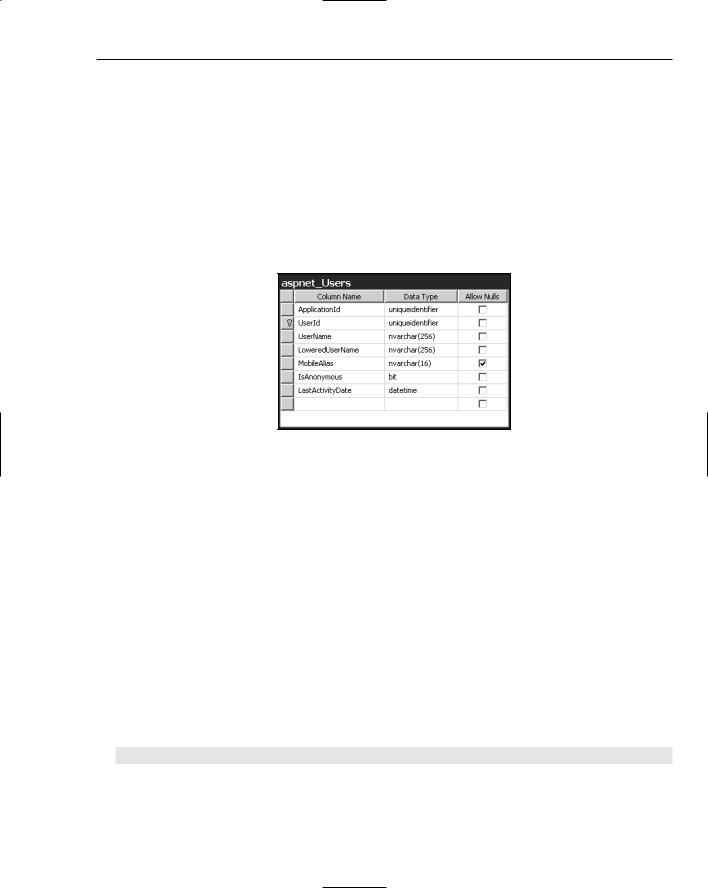
ASP.NET 2.0 Instant Results
.pdf
The Online Diary and Organizer
The default database created using the new membership features of ASP.NET 2.0 is also used. The database is a SQL Server Express database and not modified from the one created by Visual Studio Express. However, to link the log on and the diary details, the UserName field in the DiaryDB database takes its value originally from the membership database. You go through this in more detail shortly. Membership details are contained in the ASPNETDB database that Visual Web Developer Express creates for you. Although it contains quite a few tables, you never access them via the code in this project. It’s accessed exclusively by the new Login controls — it does all the hard work behind the scenes!
This project only makes use of the aspnet_Users table, shown in Figure 1-11, to provide log on security checking and provide a username for the main DiaryDB. You may well want to extend the membership database to include extra functionality such as personalizing the user experience or providing different levels of membership (admin, user, operator), among other things.
Figure 1-11
The tables of the main Online Diary database and their roles are listed in the following table:
Table Name |
Description |
|
|
Diary |
Contains details of all Online Diary users, their DiaryId, and names. |
DiaryEntry |
Contains all the diary entries for all diary users. |
DiaryEvent |
Contains all the diary events for all diary users. |
Contact |
Holds the details of all contacts for the diaries. |
|
|
The key that links all of the tables together is the DiaryId field. It’s the primary key field in the Diary table and a foreign key field in all the other tables. Why not use the UserName field? Basically speed — it’s easier and therefore faster for the database to do joins and searches on an integer field than it is on character-based fields.
All access to the database is via a stored procedure. The naming convention is simply as follows:
ActionThingThisActionRelatesTo
7

Chapter 1
Consider this very simple stored procedure:
DeleteContact
Rather unsurprisingly, DeleteContact deletes a contact from the database. The naming convention means the purpose of each stored procedure doesn’t need a lot of explanation. As the code is discussed, you look at the stored procedures in more detail where necessary.
The Business Layer
The business layer is organized into seven classes. The four main classes are as follows:
OnlineDiary
DiaryEntry
DiaryEvent
Contact
These classes do most of the work of temporarily holding diary-related data and retrieving and storing it in the database. There are also three collection classes. The first order of business is the OnlineDiary class.
The OnlineDiary Class
This class contains only two shared public methods, detailed in the following table:
Method |
Return Type |
Description |
|
|
|
InsertDiary(ByVal UserName As String, |
None |
Inserts a new diary user |
ByVal FirstName As String, ByVal |
|
into the OnlineDiary |
LastName As String) |
|
database. |
GetDiaryIdFromUserName(ByVal |
Integer |
Looks up the UserName |
UserName As String) |
|
in the database and returns |
|
|
the associated DiaryId. |
The purpose of the OnlineDiary class is simply to provide a couple of handy shared methods relating to an online diary as a whole. It could also be used to expand the diary system and add new functionality that relates to the overall diary system, rather than a specific part such as contacts.
The Contact Class
The Contact class objectifies a single contact — a person or thing for which you want to store contact information. It encapsulates everything to do with contacts, including the storing and retrieving of contact information in the database.
8

The Online Diary and Organizer
It has two constructors, outlined in the following table:
Constructor |
Description |
New(ByVal Diaryid as Integer) Creates a new Contact object with all properties set to their default values.
New(ByVal ContactId As Long) Creates a new Contact object with its properties retrieved from the database using the argument ContactId.
Having created a Contact object, saving it involves simply calling the Save() method. The class will work out whether it’s a new contact that needs to be inserted into the database, or an existing one that needs to be updated. In addition to the Save() method, the Contacts class contains two Delete() methods, as well as two GetContacts() methods, all of which are outlined in the following table:
Method |
Return Type |
Description |
|
|
|
Save() |
None |
Saves a fully populated Contact |
|
|
object. If it’s a new contact, Save() |
|
|
calls InsertNewContact sub, and |
|
|
the details are inserted into the |
|
|
database. The new ContactId is |
|
|
returned from the database and |
|
|
entered into mContactId. If the con- |
|
|
tact already exists in the database, |
|
|
Save() calls UpdateContact, which |
|
|
updates the database values with |
|
|
those in the Contact object. |
DeleteContact() |
None |
Deletes from the database the Con- |
|
|
tact object with ContactId equal to |
|
|
mContactId of the object. Contact |
|
|
object’s values are re-initialized to |
|
|
their defaults. |
DeleteContact(ByVal |
None |
Shared method that deletes the |
ContactId As Long) |
|
Contact object from the database |
|
|
with a ContactId value equal to the |
|
|
ContactId argument of the method. |
GetContactsByFirstLetter(ByVal |
SqlDataReader Shared method that returns a |
|
DiaryId As |
|
SqlDataReaderobject populated |
Integer,Optional ByVal |
|
with a list of contacts whose |
FirstLetterOfSurname |
|
surname’s first letter matches the |
As Char) |
|
FirstLetterOfSurname argu- |
|
|
ment.This argument is optional; if |
|
|
left off, all Contact objects regard- |
|
|
less of surname’s first letter are |
|
|
included in the DataSet’s rows. |
|
|
Table continued on following page |
9

Chapter 1
Method |
Return Type |
Description |
|
|
|
GetContactsByFirstLetterAsCollection(ByVal |
SqlDataReader |
Shared method |
DiaryId As Integer, Optional ByVal |
|
that returns a |
FirstLetterOfSurname As Char) |
|
ContactCollection |
|
|
object populated |
|
|
with Contact objects |
|
|
whose surname’s first |
|
|
letter matches the |
|
|
FirstLetterOfSurname |
|
|
argument. This argument |
|
|
is optional; if left off, all |
|
|
Contact objects regard- |
|
|
less of surname’s first |
|
|
letter are included in |
|
|
the DataSet’s rows. |
|
|
|
Finally, the Contact class contains the following properties:
Property |
Type |
Description |
|
|
|
ContactId |
Long |
Each contact is represented by a unique ID. The ID is auto- |
|
|
generated by the Contact table in the database whenever a |
|
|
new contact is inserted. |
FirstName |
String |
Contact’s first name. |
LastName |
String |
Contact’s surname. |
String |
Contact’s e-mail address. |
|
Telephone |
String |
Contact’s telephone number. |
MobilePhone |
String |
Contact’s mobile phone number. |
AddressLine1 |
String |
Contact’s house name and street address. |
City |
String |
Contact’s city of residence. |
State |
String |
Contact’s state. |
PostalCode |
String |
Contact’s zip or postal code. |
|
|
|
The ContactCollection Class
The ContactCollection class inherits from the System.Collections.CollectionBase class. The
ContactCollection class’s purpose is simply to store a collection of Contact objects. This class gets extensive use in the next chapter, when you create a contacts organizer.
10

The Online Diary and Organizer
The ContactCollection class has only one property:
Property |
Type |
Description |
|
|
|
Item(ByVal Index As Integer) |
Integer |
Returns the Contact object stored at the |
|
|
position in index in the collection. |
The ContactCollection class’s public methods are as follows:
Method |
Return Type |
Description |
|
|
|
Add(ByVal NewContact As Contact) |
None |
Adds a Contact object to |
|
|
the collection held by the |
|
|
ContactCollection object. |
Add(ByVal ContactId As Long) |
None |
Creates a new Contact object. |
|
|
ContactId is passed to the |
|
|
Contact object’s constructor |
|
|
to ensure it’s populated with |
|
|
the contact’s details from the |
|
|
database. The new Contact |
|
|
object is then added to the |
|
|
collection maintained by the |
|
|
ContactCollection object. |
Remove(ByVal Index as Integer) |
None |
Removes the Contact object |
|
|
from the collection at the speci- |
|
|
fied index. |
|
|
|
That deals with the Contact classes; now take a look at the two classes dealing with diary entries.
The DiaryEntry Class
The DiaryEntry class objectifies a single entry in a diary. It encapsulates everything to do with diary entries, including creating, updating, and retrieving diary entry data. It handles all the database access for diary entries.
It has three constructors, outlined in the following table:
Constructor |
Description |
New(ByVal DiaryId as Integer) Creates a new DiaryEntry object with all properties set to their default values.
New(ByVal DiaryEntryId As Long) Creates a new DiaryEntry object with its properties retrieved from the database using the argument
DiaryEntryId.
New(ByVal DiaryId AS Integer, Creates a new DiaryEntry object with its properties
ByVal EntryDate As Date) retrieved from the database using the arguments
DiaryId and EntryDate.
11

Chapter 1
Having created a DiaryEntry object, saving it involves simply calling the Save() method. As with the Save() method of the Contacts class, the DiaryEntry class will work out whether it’s a new diary entry that needs to be inserted into the database, or an existing entry that needs to be updated. As well as enabling retrieval of one diary entry’s details, the DiaryEntry class provides additional methods for getting details of a number of diary entries as either a collection or as a DataSet by returning a sqlDataReader object. The methods of this class are explained in the following table:
Method |
Return Type |
Description |
|
|
|
Save() |
None |
Saves a fully populated |
|
|
DiaryEntry object. If it’s a |
|
|
new entry, Save() calls |
|
|
InsertNewDiaryEntry |
|
|
sub and the details are |
|
|
inserted in to the database. |
|
|
The new DiaryEntryId is |
|
|
returned from the database |
|
|
and entered in to mDi- |
|
|
aryEntryId. |
|
|
If the entry already exists |
|
|
in the database, Save() |
|
|
calls UpdateContact, |
|
|
which updates the |
|
|
database values with those |
|
|
in the DiaryEntry object. |
GetDaysInMonthWithEntries(ByVal |
Boolean Array |
Shared method that |
DiaryId As Integer, ByVal Month |
|
returns a Boolean |
As Integer, ByVal Year As |
|
|
Integer) |
|
array detailing which days |
|
|
have a diary entry associ- |
|
|
ated with them. The array |
|
|
index matches with the |
|
|
day of the month (1 is the |
|
|
first of the month, 2 the |
|
|
second, and so on). |
GetDiaryEntriesByDate(ByVal |
SqlDataReader |
Shared method |
DiaryId As Integer, ByVal |
|
that returns a |
FromDate As Date, ByVal ToDate |
|
SQLDataReader object |
As Date) |
|
populated with rows from |
|
|
the database detailing |
|
|
diary entries between the |
|
|
FromDate and ToDate |
|
|
arguments. |
|
|
|
12

The Online Diary and Organizer
Method |
Return Type |
Description |
|
|
|
GetDiaryEntriesByDateAsCollection(ByVal |
DiaryEntryCollection |
Creates a new |
DiaryId As Integer, ByVal FromDate |
|
DiaryEntry |
As Date, ByVal ToDate As Date) |
|
Collection |
|
|
object and populates |
|
|
it with DiaryEntry |
|
|
objects whose |
|
|
EntryDate is |
|
|
between the |
|
|
FromDate and |
|
|
ToDate arguments. |
GetDiaryEntriesRecentlyChanged(ByVal |
SqlDataReader |
Returns a |
DiaryId As Integer) |
|
SqlDataReader |
|
|
containing a DataSet |
|
|
of diary entries |
|
|
recently created. |
|
|
|
In addition to the constructors and methods, the DiaryEntry class contains the following properties:
Property |
Type |
Description |
|
|
|
EntryTitle |
String |
Title for the day’s diary entry. |
EntryText |
String |
Text of the day’s diary entry. |
EntryDate |
Date |
Date the entry was posted. |
|
|
|
The other class dealing with diary entries is the DiaryEntryCollection class, which is explained next.
The DiaryEntryCollection Class
The DiaryEntryCollection class inherits from the System.Collections.CollectionBase class. Its purpose is simply to store a collection of DiaryEntry objects.
This class contains only one property, described in the following table:
Property |
Type |
Description |
|
|
|
Item(ByVal Index As |
Integer |
Returns the DiaryEntry object stored |
Integer) |
|
at the specified position in index in the |
|
|
collection. |
|
|
|
13

Chapter 1
Along with the Item() property, the DiaryEntryCollection class has three public methods:
Method |
Return Type |
Description |
|
|
|
Add(ByVal New DiaryEntry |
None |
Adds a DiaryEntry object to the collection |
As DiaryEntry) |
|
held by the DiaryEntryCollection |
|
|
object. |
Add(ByVal DiaryEntryId |
None |
Creates a new DiaryEntry object. |
As Long) |
|
DiaryEntryId is passed to the |
|
|
DiaryEntry object’s constructor to ensure |
|
|
it’s populated with the diary entry’s details |
|
|
from the database. The new DiaryEntry |
|
|
object is then added to the collection main- |
|
|
tained by the DiaryEntryCollection |
|
|
object. |
Remove(ByVal Index as |
None |
Removes the DiaryEntry object from the |
Integer) |
|
collection at the specified index. |
So far the classes dealing with contacts and diary entries have been discussed. The next section discusses the diary events.
The DiaryEvent Class
The DiaryEvent class objectifies a single entry in a diary. It encapsulates everything to do with diary entries, including creating, updating, and retrieving diary events data. It handles all the database access for diary events.
The DiaryEvent class has three constructors, outlined as follows:
Constructor |
Description |
New(ByVal Diaryid as Integer) Creates a new DiaryEvent object with all properties set to their default values.
New(ByVal EntryId As Long) Creates a new DiaryEvent object with its properties retrieved from the database using the argument EventId.
New(ByVal DiaryId AS Integer, Creates a new DiaryEvent object with its properties
ByVal EventDate As Date) retrieved from the database using a combination of the arguments DiaryId and EventDate.
Having created a DiaryEvent object, saving it involves simply calling the Save() method. The class will work out whether it’s a new diary event to insert into the database, or an existing one in need of updating. The DiaryEvent class also has two Delete() methods. One is a shared method and therefore doesn’t require a DiaryEvent to be created, and requires an EventId parameter. It’s used by some of the built-in data access components provided with ASP.NET 2.0. The second is an object method that deletes the event referenced by the current DiaryEvent object. As well as enabling the details of one diary entry to be retrieved, the DiaryEvent class provides additional methods for getting details of a number of diary events as either a collection or as a DataSet by returning a SqlDataReader object.
14

The Online Diary and Organizer
The following table explains these methods in detail:
Method |
Return Type |
Description |
|
|
|
Save() |
None |
Saves a fully populated |
|
|
DiaryEvent object. If it’s |
|
|
a new entry, Save() calls |
|
|
InsertNew DiaryEvent |
|
|
sub and the details are |
|
|
inserted into the data- |
|
|
base. The new EventId |
|
|
is returned from the |
|
|
database and entered |
|
|
in to mEventId. |
|
|
If the entry already |
|
|
exists in the database, |
|
|
Save() calls |
|
|
UpdateDiaryEvent, |
|
|
which updates the |
|
|
database values with |
|
|
those in the DiaryEvent |
|
|
object. |
GetDaysInMonthWithEvents(ByVal |
Boolean Array |
Shared method that |
DiaryId As Integer, ByVal |
|
returns a Boolean array |
Month As Integer, ByVal Year |
|
detailing which days |
As Integer) |
|
have events associated |
|
|
with them. The array |
|
|
index matches with the |
|
|
day of the month (1 is the |
|
|
first of the month, 2 the |
|
|
second, and so on). |
GetDiaryEventsByDate(ByVal DiaryId |
SqlDataReader |
Shared method |
As Integer, ByVal FromDate As Date, |
|
that returns a |
ByVal ToDate As Date) |
|
SqlDataReader object |
|
|
populated with rows |
|
|
from the database detail- |
|
|
ing diary events between |
|
|
the FromDate and |
|
|
ToDate arguments. |
GetDiaryEventsByDateAsCollection(ByVal |
DiaryEventCollection |
Creates a new Diary |
DiaryId As Integer, ByVal FromDate As |
|
EventCollection |
Date, ByVal ToDate As Date) |
|
object and populates it |
|
|
with DiaryEvent objects |
|
|
whose EntryDate is |
|
|
between the FromDate |
|
|
and ToDate arguments. |
|
Table continued on following page |
|
15

Chapter 1
Method |
Return Type |
Description |
|
|
|
DeleteEvent() |
None |
Deletes from the database the |
|
|
event with EventId equal to |
|
|
mEventId of the object. The |
|
|
DiaryEvent object’s values are |
|
|
re-initialized to their defaults. |
DeleteEvent(ByVal EventId As Long) |
None |
Shared method that deletes the |
|
|
event from the database with |
|
|
an EventId value equal to the |
|
|
EventId argument of the |
|
|
method. |
|
|
|
In addition to the constructors and public methods, the DiaryEvent class has these four properties:
Property |
Type |
Description |
|
|
|
EventDescription |
String |
Description of the event. |
EventName |
String |
Short name for the event. |
EventDate |
Date |
Date the event starts. |
EventDuration |
Integer |
Length of time in minutes that the event lasts. |
One more class to go. The next section looks at the diary collection handling class:
DiaryEventCollection.
The DiaryEventCollection Class
The DiaryEventCollection class inherits from the System.Collections.CollectionBase class. Its purpose is simply to store a collection of DiaryEvent objects. The class employs the following methods:
Method |
Return Type |
Description |
|
|
|
Add(ByVal NewDiaryEvent As |
None |
Adds a DiaryEvent object to the collection |
DiaryEvent) |
|
held by the DiaryEventCollection |
|
|
object. |
Add(ByVal DiaryEventId |
None |
Creates a new DiaryEvent object. |
As Long) |
|
DiaryEventId is passed to the |
|
|
DiaryEvent object’s constructor to ensure |
|
|
it’s populated with the event’s details from |
|
|
the database. The new DiaryEvent object |
|
|
is then added to the collection maintained |
|
|
by the DiaryEventCollection object. |
Remove(ByVal Index As |
None |
Removes the DiaryEvent object from the |
Integer) |
|
collection at the specified index. |
|
|
|
16
